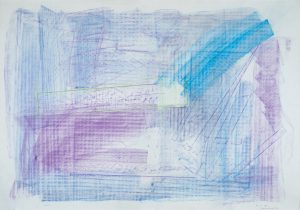
György JOVÁNOVICS
Frottage 1.
- Year(s)
- 1993
- Technique
- colour pastel
- Size
- 70x100 cm
Artist's introduction
György Jovánovics studied sculpture at the Hungarian College of Fine Arts, followed by further studies in Vienna and Paris. He is a winner of the Kossuth Prize and a member of the Széchenyi Academy of Letters and Arts. His work speaks about art itself through the objective nature of sculpture and the presentation of elusive artistic qualities. The – archaic and simultaneously contemporary – material often utilised in his work is plaster, which is also connected to his first themes: the figure and drapery (Iparterv exhibitions in 1968 and 1969). His life-sized figures (including those isolated from the realm of painting) are assembled from parts, casts, as well as his space-defining drapery installations (Adolf Fényes-Hall, 1970). In these works, Jovánovics presents an object-oriented creative process and a fragile existential interpretation of art. (The artwork titled Precurtain for the Ecstatic Marionette (1979) has become a part of the Tate Modern collection.) From the 1980s, Jovánovics started exploring the classic art genre of the sculptural relief. Based on minimal spatial differences, his white plaster reliefs are brought to life by frictional light from an external source. With time, coloured versions also appeared, using different paints that were mixed into the material. In his frottage work, he unfolds the possibilities of the relief format and questions of light and colour. The monument commemorating the martyrs of the Hungarian Revolution of 1956 – which included the layout plan of the surrounding space of the New Public Cemetery as well – revealed the meaningful connections between architecture and sculpture, deep and high, closed and open spaces, space and surfaces in general, furthermore the connection between architectural and sculptural archetypes. His video installation titled An excerpt from the Great Storm explored the unity of the three arts based on a painting by Giorgione and revealed the liveliness a work of contemporary art can possess (BTM - Kiscelli Museum, 1996). Katalin Keserü
More artworks in the artist's collection »


